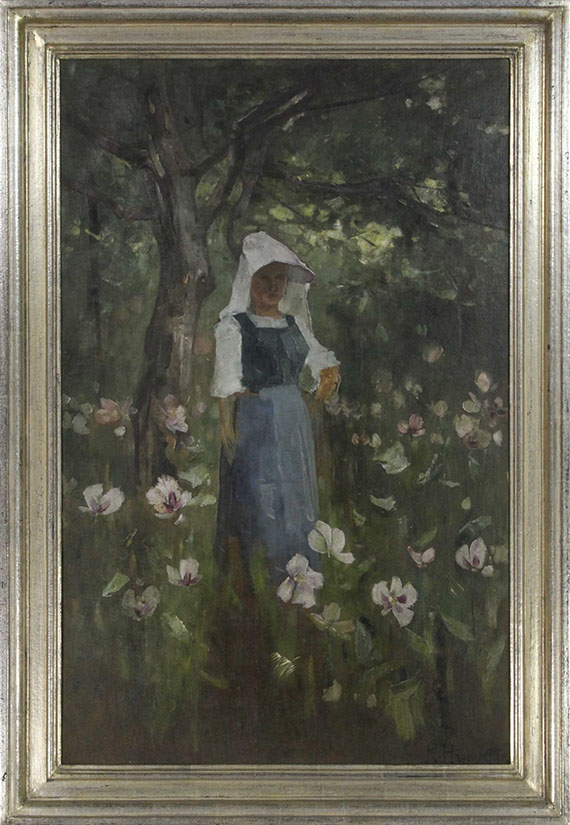39
Karl Hagemeister
Wendische Bäuerin, Um 1886.
Oil on canvas
Estimate:
€ 10,000 / $ 11,800 Sold:
€ 16,250 / $ 19,175 (incl. surcharge)
Wendische Bäuerin. Um 1886.
Oil on canvas.
Warmt G 190. Signed in lower right. 100.4 x 64.4 cm (39.5 x 25.3 in).
• one of the rare figure pictures by the landscape painter .
We are grateful to Dr. Hendrikje Warmt, Karl Hagemeister Archive & Catalog Raisonné Berlin, for her kind support in cataloging this lot.
PROVENANCE: Private collection Hamburg
Galerie Gerda Bassenge, Berlin, auction on November 7-11, 1967, lot 792 ("Bauernmädchen im Garten", with illu. on p. 131).
Kunstantiquariat Arno Winterberg, Heidelberg, auction on May 4, 1974, lot 554 ("Märkisches Bauernmädchen in Blumenwiese", with illu. on p. 142).
Kunstkabinett Schirmer, Stuttgart.
Private collection Southern Germany (acquired from aforementioned in ca. 1975, since then family property).
EXHIBITION: Große-Kunstausstellung, no place and date (verso of stretcher with fragments of the exhibition labelt, presumably: Arthur Dahlheim, Berlin 1918, "Mädchen im Garten", no dims./illu.).).
"If you paint landscapes, you have to go where landscapes are; if you paint princesses, you have to go where princesses are."
Karl Hagemeister, quote after: Hendrijke Warmt, Karl Hagemeister. In Reflexion der Stille, Berlin 2016, p. 130.
Oil on canvas.
Warmt G 190. Signed in lower right. 100.4 x 64.4 cm (39.5 x 25.3 in).
• one of the rare figure pictures by the landscape painter .
We are grateful to Dr. Hendrikje Warmt, Karl Hagemeister Archive & Catalog Raisonné Berlin, for her kind support in cataloging this lot.
PROVENANCE: Private collection Hamburg
Galerie Gerda Bassenge, Berlin, auction on November 7-11, 1967, lot 792 ("Bauernmädchen im Garten", with illu. on p. 131).
Kunstantiquariat Arno Winterberg, Heidelberg, auction on May 4, 1974, lot 554 ("Märkisches Bauernmädchen in Blumenwiese", with illu. on p. 142).
Kunstkabinett Schirmer, Stuttgart.
Private collection Southern Germany (acquired from aforementioned in ca. 1975, since then family property).
EXHIBITION: Große-Kunstausstellung, no place and date (verso of stretcher with fragments of the exhibition labelt, presumably: Arthur Dahlheim, Berlin 1918, "Mädchen im Garten", no dims./illu.).).
"If you paint landscapes, you have to go where landscapes are; if you paint princesses, you have to go where princesses are."
Karl Hagemeister, quote after: Hendrijke Warmt, Karl Hagemeister. In Reflexion der Stille, Berlin 2016, p. 130.
From the 1880s to the first years of the following decade, the work of the landscape artist Karl Hagemeister occasionally includedanimal and figure portraits. In addition to hunters, Hagemeister was especially fond of young peasant women as hismotif, which he depicted performing their work on the fields (cf.Warmt G 165-168, 1885) or during their leisure timein blooming flower fields (cf.Warmt G 185, G 189-195, 1886, G 222-223, 1888, and G230-236, 1889). Hagemeister found his models in and around the town of Ferch where he lived between 1880 and 1891/92. These were the decisive years during which he attained his personal style, a style largely characterized by latest developments in French art. For his depictions of figures from the simple, rural environment, Jean-François Millet and Jules Bastien-Lepage, as well as German contemporary Fritz von Uhde deserve to be mentioned as sources of inspiration. Hagemeister had a preference for the Wendish costume, which consisted of simple dresses waisted by full-length aprons and towering, white hoods. This canalso be observed in the composition offered here, which shows a young peasant woman in the middle of a lush poppy field on the edge of a forest. Her white hood, like the surrounding flower heads, shines brightly from the deep green play of light and shadow in the forest. Her straight posture with the left arm casually pressed against the hip gives her a proud aura that is in no way inferior to a classical statue. With the rather archetypical depiction of the figure without clearly defined facial features, as well as with his pure landscape pictures – Hagemeister shows that he was primarily interested in rendering the general atmospheric impression and that he wanted to give the observer an idea of the native beauty of man and nature. [FS]
39
Karl Hagemeister
Wendische Bäuerin, Um 1886.
Oil on canvas
Estimate:
€ 10,000 / $ 11,800 Sold:
€ 16,250 / $ 19,175 (incl. surcharge)
Headquarters
Joseph-Wild-Str. 18
81829 Munich
Phone: +49 89 55 244-0
Fax: +49 89 55 244-177
info@kettererkunst.de
Louisa von Saucken / Undine Schleifer
Holstenwall 5
20355 Hamburg
Phone: +49 40 37 49 61-0
Fax: +49 40 37 49 61-66
infohamburg@kettererkunst.de
Dr. Simone Wiechers / Nane Schlage
Fasanenstr. 70
10719 Berlin
Phone: +49 30 88 67 53-63
Fax: +49 30 88 67 56-43
infoberlin@kettererkunst.de
Cordula Lichtenberg
Gertrudenstraße 24-28
50667 Cologne
Phone: +49 221 510 908-15
infokoeln@kettererkunst.de
Hessen
Rhineland-Palatinate
Miriam Heß
Phone: +49 62 21 58 80-038
Fax: +49 62 21 58 80-595
infoheidelberg@kettererkunst.de
We will inform you in time.




 Lot 39
Lot 39 

